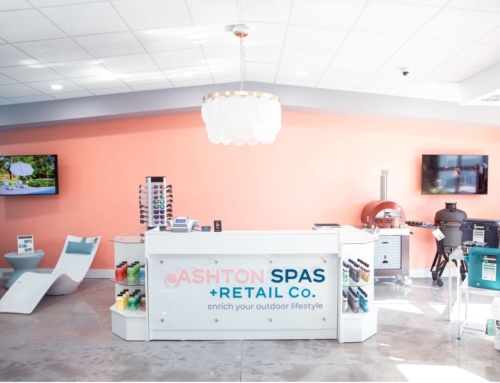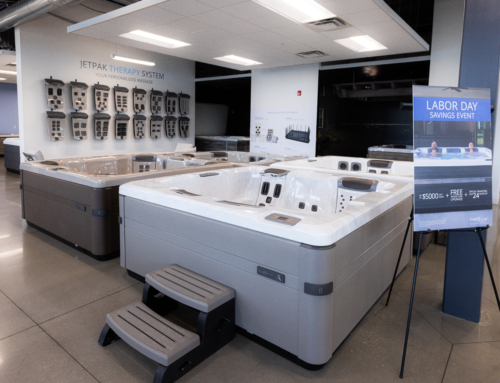We’ve all had the occasional customer walk in and ask if we sell spas with saltwater systems. One of the biggest hurdles to selling hot tubs is the perception that saltwater systems could be healthier than their chlorine counterparts, and that they might also require significantly less maintenance than a chlorine system.
There’s a lot of hype about saltwater systems that can be very convincing to your customers. The goal for every spa dealer should be to address these beliefs and questions head on, and with confidence. “The salesperson who is most successful at converting a customer who believes they want saltwater is the one who doesn’t get automatically defensive, and instead listens to what the customer is really asking,” says Dave Henderson, a regional manager with Bullfrog Spas.
Most customers who come in asking about saltwater systems don’t know much about them. What they’re really asking is what is the most efficient, environmentally friendly, and healthy way to care for spa water—and how hard is it to maintain? “It’s all about asking the right questions,” says Henderson. “The goal is to figure out why they’re asking about saltwater so you can explain why there is only one manufacturer in the world that actually sells this type of system.”
If we go into the conversation assuming that the customer wants saltwater simply because they ask about it, we risk coming across as defensive, and less professional. In most cases, saltwater systems are not being sold as making chlorine. The solution to this is to explain that saltwater systems require fewer chemicals and therefore produce softer, cleaner water. But the truth is that salt is a chemical, and adding it to water generates a chemical reaction that creates chlorine. Meaning that if the spa water is clean, that spa has been chemically mixed to create chlorine, even when it starts out as salt.
“Ask your prospect what they like about the idea of saltwater, and move forward that way. Keep asking what else, until the prospect runs out of selling points,” explains Henderson. “Next, be sure to give them credit for what they probably know by explaining, ‘I’m sure you’re familiar with it, but you know that a salt generator produces chlorine, right?’ and then ask if they’ve ever heard of a mineral water system. From there, you can launch into explaining about how FROG @ease works.”
Is a Saltwater System Self-Maintaining?
Another myth associated with saltwater systems is that the system itself is self-maintaining, which requires little or no effort from spa owners. Sound too good to be true? That’s because it is. No matter which spa your customer buys, it’s going to hold hundreds of gallons of stagnant water. Untreated stagnant water tends to allow microorganisms, like mold or algae, to grow on spa surfaces. No matter which system your customers choose, their spa water is going to require care. That care will 100% involve adding some type of salt or other chemicals that create a chlorine reaction.
A number of spa dealers who are pushing saltwater systems are selling the idea that it’s better for the customer’s skin. This is where it helps to explain the benefits of mineral water, and how much better it can be for skin and hair, as well as the spa’s working components—which is something saltwater systems are notorious for destroying.
Are Saltwater Systems Cheaper Long-Term?
Another objection you might face is the long-term maintenance costs. Saltwater maintenance is cheaper than chlorine—theoretically. However, it’s a much bigger up-front investment, because saltwater hot tubs start out at a higher price point. In addition, cartridges will need to be replaced in more frequent intervals.
When you factor that in with the way salt damages spa components and how soon certain spa components will need to be replaced, is it really cheaper? It’s really not. The only real benefit is that customers have to go out and buy salt, instead of chlorine.
Do Saltwater Spa Components Last Longer than Chlorine Spa Components?
We know that saltwater systems have been used in pools since the 1970’s, but no manufacturer has used one in a hot tub until recently, and there are good reasons for that. Mostly, those reasons have to do with better, more updated systems being available.
What prospects might not realize is that salt builds up, creating a filmy residue on basically everything it touches. This includes spa components, pumps, plumbing, shell—everything. If you’ve ever seen an older-model car that has rust corrosion, you’ve seen firsthand what happens when salt has its way. The same corrosion happens to spa components when using a saltwater system.
What it means for your customer is that damaged components will have to be replaced much sooner than they would in the same exact spa model that could also operate on a chlorine system.
If your prospect asks if Saltwater chemistry is easier on spa surfaces, it might help to explain to them that salt + ions = calcium. Higher salt content means higher calcium levels. Calcium is what causes those ridiculously tough-to-remove spots in your sink, or on your car when it inadvertently gets hit by sprinklers.
Saltwater Systems Must Maintain a Specific Temperature
If the prospect has plans of letting their hot tub get cold—whether intentionally or not—they need to understand that saltwater systems must be kept above 60 degrees Fahrenheit in order to keep the system working. Most salt systems automatically shut down when the water gets cooler than that, which can create a breeding ground for microorganisms. Suddenly, the saltwater spa desperately needs chlorine.
Explaining Chlorine and the FROG @ease System
Now that you’ve explained a bit about how saltwater systems work, your prospect might have similar questions about what other systems are available. Bullfrog Spas offer a combination of mineral water and chlorine, which can be upgraded with oxidizers in some of the most hygienic spa water options available.
Chlorine is an element that is naturally gaseous at room temperature. When combined in water with oxygen and hydrogen, it forms hypochlorous acid. This compound is highly effective at killing bacteria, such as E. coli and salmonella, as well as the influenza virus. Typically, chlorine is added to spa water in either a liquid or a dissolvable solid form, so the acidic properties are generally contained and dispersed within the water, killing any bacteria living there.
FROG @ease for Bullfrog Spas is a simple, yet powerful and effective, water sanitizing system developed specifically for use with Bullfrog Spas hot tubs. Sometimes, even when customers seem to be following proper procedures, the experience may not match expectations because there are many variables that go into water sanitizing.
Closing the Sale on a Bullfrog Spa
No matter which spa your customers choose, their water care system is going to require about the same amount of effort on their part. There is simply no care-free solution to spa water maintenance. However, if your customers really want options for lower maintenance, a self-regulating chlorine system, like Bullfrog Spas FROG @ease is a much better option than salt water because it’s newer technology that is proven safer and more effective.
This system creates fresh clean mineral water, while self-regulating SmartChlor® technology maintains low chlorine levels. With FROG @ease in their spa, your customers will use up to 75% less chlorine, reducing the need for shock treatments to once a month, while protecting swimwear and skin. For customers who are looking for the best of both worlds, this is a great place to start.
The best part is that it’s available for every model and every trim level of all Bullfrog Spa lines. This means customers can truly choose a spa that is personalized for them so it’s exactly what they’re hoping for, and since they’re using minerals instead of salt, that spa will come backed by one of the best warranties in the industry.








Leave A Comment